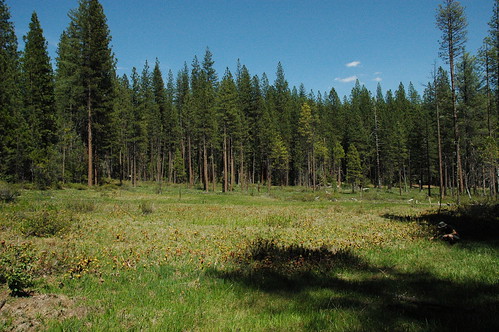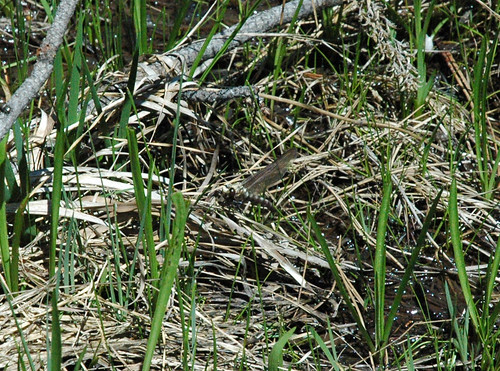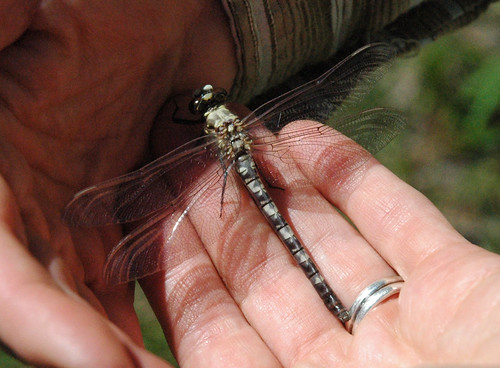I have returned from an epic nature adventure with many friends, combining events celestial and botanical! The timing of the annular eclipse of the Sun coincided with the blooming of native pitcher plants in Butterfly Valley, a place my wife has been yearning to visit for years. And that was right near the town of Quincy, a beautiful mountain town where we could get prime latitudinal (and fog-free) sun-viewing. And I hoped we would get a chance to encounter very unique dragonfly, Tanypteryx hageni, the black petaltail.
Our friends are a rabble of plant-fanciers, birders, rockhounds, star-gazers, artists, engineers, historians, insectophiles, and general lovers of science geekery. Give us a 10 foot square of land, and we’ll dawdle for hours, exploring and admiring the natural and constructed world. An advance group of us raced up to Quincy to meet up with Jim Battagin, a knowledgeable botanist who gave us a personal tour of the nearby Butterfly Valley Botanical Area. This region of the Northern Sierra Nevada forest is full of unique orchids, lilies, and amazing native carnivorous plants. It was Battagin who mentioned that Butterfly Valley had a “very unique insect” some weeks back. I deduced that he was talking about the beautiful T. hageni, and devoured all the information I could online.
The black petaltail is a large and striking dragonfly. Petaltails are so named because the males often have large flat cerci on the ends of their abdomens. They are remarkable for several reasons. Firstly, the Petaluridae are known as “ancient dragonflies”. That is, of all the living dragonflies, they have the longest fossil record. And since dragonflies have been around before the dawn of terrestrial vertebrates, that’s a pretty long lineage.
The second reason petaltails are strange, and why they’re so hard to find, is that they exist only in bogs that are fed by fresh seeps, known as fens. Fens have a continuous supply of fresh water running through them, and are never entirely still. But they’re muddy and shallow, and instead of living in a proper river or stream, the black petaltail’s aquatic nymph spends its life in a watery mud-burrow, leaping out to catch prey when it ambles by. Most dragonflies live a year as a nymph, crawling up out of the water on a branch, then bursting out as a winged adult. And that’s where the black petaltail is really bizarre. Tanypteryx hageni lives up to five years as a nymph. Researchers still don’t know fully why, or whether it varies at all, but that’s a freaky-long time to stay in nymph-school. The adults still don’t last more than a few months, eating insects on the wing, then mating and expiring before the year is out.
Sadly, when we arrived in Quincy, our guide informed us that we were about a month too early to see the adults emerge. We didn’t mind, because we spent several days re-visiting the region and geeking out over the insanely bizarre carnivorous plants! It was on one of these return trips that my wife noticed the Really Big Damselfly near the ground.
I knew right away it might be something special- first off, it was clearly a dragonfly, but its wings were still upright, so it must have just molted. Secondly, there was no stream or lake nearby- where did it come from? A small water-soaked mud flat was directly under it. I immediately made a gentle grab for the dragonfly, and got a close-up look.
Even though its greyish colors were still darkening, there was no denying it- we’d found a black petaltail! Cradled in my wife’s hands was a five-year-old insect, ready for its final stage of life. Once its wings and skin had thoroughly hardened, the dragonfly snapped them into place into a lateral position, gave a test vibration, then took off. Had we been 30 minutes later, we would have missed the whole spectacle. We found her exuviae on a stalk below, and friends found at least 2 others in the region. So clearly we’d arrived just as they were emerging, a wonderful chance event! We were elated, and ready to explore more of this amazing region.
Next post I’ll blab more about insect-eating plants, promise! ![]()






2 Responses to The Black Petaltail of Butterfly Valley